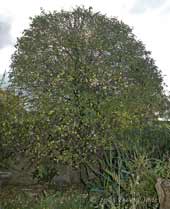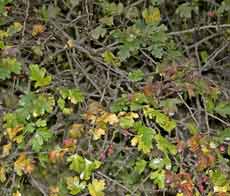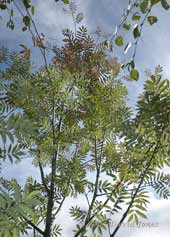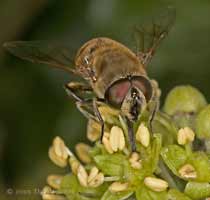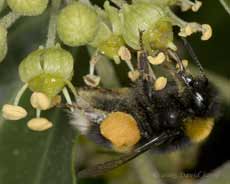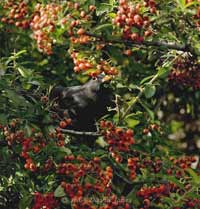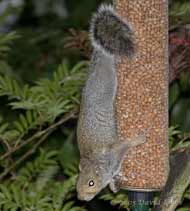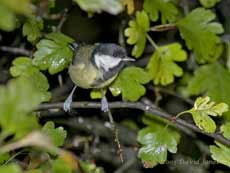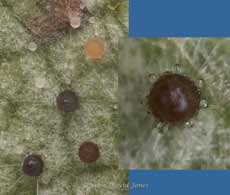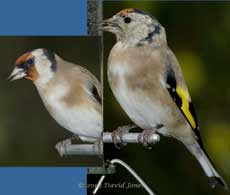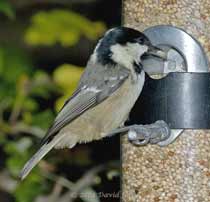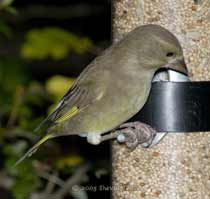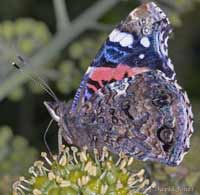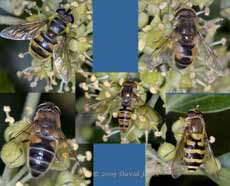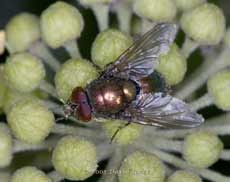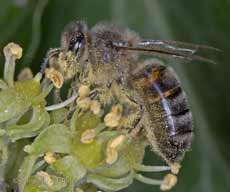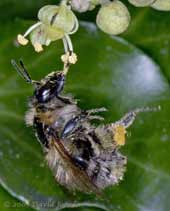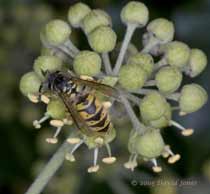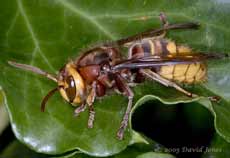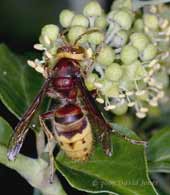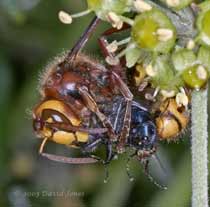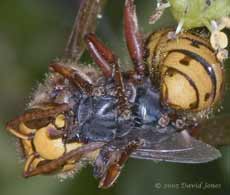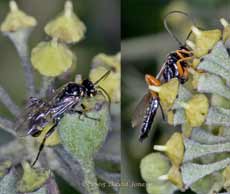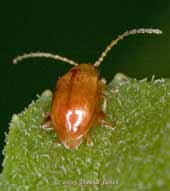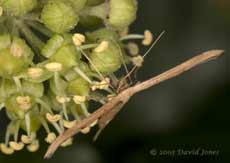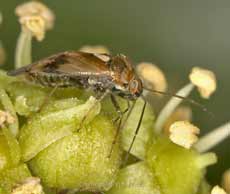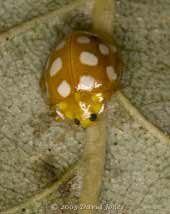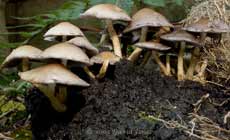Go to the last entry on this page .....Go to previous entry22 October - A largely cloudy day, with some bright spells and just the one shower. We had quite a bit of rain over the previous two days. A continuing problem with energy levels caused the gap in the diary, but I have been out with the camera today.
The Hawthorn is fast losing its leaves now. In fact, we can now see through it for the first time this Autumn, and the ground below has a leaf carpet.
This second image is of the same area of
the tree that I photographed on the 13th, showing the gaps that have
appeared in the leaf cover.
At the other end of the garden the Birch is still green while the Rowan is now turning red, starting at the top. Along the fence up at the West Wing, the Chilean Potato Vine is growing as though it's still summer, and I spent a bit of time pruning part of it.
The Ivy continues to flower, with its
strong aroma, and with lots of buds still waiting to open. Today you could
hear the insects around it. It certainly looked as though the large
Hoverflies had the place almost to themselves. There were few 'true flies'
and just a couple of wasps.
A Red Admiral visited again and this Bumble Bee must have spent ages there, judging by the amount of pollen gathered in its hind legs.
The Goldfinches continue to visit to the extent there rarely do more than a few minutes go by when there isn't at least one at the feeders. This morning I spotted a Coal Tit again, this time at a fat ball. The House Sparrows are in the Hawthorn for long periods through the day, and the whole neighbourhood can hear them when they are in residence. A Dunnock is a frequent visitor now, and I often see it in conflict.
The garden again has a pair of Blackbirds visiting regularly. While the female finds food on the ground, the male is more likely to be seen up in the Pyracantha which is against the fence between the Hawthorn and the veranda. I must try to get a shot of it with a berry in its beak. Compared with the Pyracantha the hawthorn is almost bare of berries, which is disappointing after its good show of blossom in May. 24 October - An overcast, damp and breezy day, but not cold outside (15C at 1pm) - I bowed to the inevitable this morning and put away my sandals and shorts until the Spring! Considering the conditions, it was almost a contradiction in terms to watch a Red Admiral fluttering around the Ivy flowers.
While I was watching the butterfly from our bedroom window a surprise visitor appeared on the caravan shelter - a Grey Squirrel. The last record of my seeing one in the garden was back in September 2003. By the time I collected my camera (and changed the lens!) it had leapt across to the peanut feeder where it posed just long enough for me to get a couple of shots.
In addition to the Blackbirds, our regular Goldfinches (10 this morning), the group of Blue Tits (6) and the Sparrow flock, this morning we have had a male Greenfinch, a Coal Tit and this Great Tit, which was much more nervous about going to the fat balls than its smaller cousins. I was surprised how blue its legs appeared in the photographs I took.
25 October - A largely dry but blustery day on which our Birch started to shed its leaves.
Some of the leaves are speckled with tiny dark dots. These are the fruiting bodies of the mildew. They start off white and gradually darken as they grow. The largest spheres I measured at around 0.22mm across and the largest ones often have straight filaments radiating out from them. Also, when they are first brought indoors you can see droplets of water(?) around them. When I checked the tree this afternoon I could only see a few Orange Ladybirds. In fact, I caught sight of one flying up to a bamboo plant from under the Birch. I wonder if the leaf it had been on had fallen from the tree today. A couple more bird sightings to note today. First of all, there was a Wren which spent time hunting amongst the Flag Irises at the margin of the small pond during the morning. Just after it left, two Greenfinches (1 male, 1 female) came to the bird table for just one visit.
26 October - A dry, cloudy and generally dull day. We were out for much of the time so I hardly set foot in the garden, other than to replenish the feeder supplies.
The right hand image shows how the juveniles have still to develop the red face and crisper looking plumage of the adults (left).
I had only taken a few pictures when a Coal Tit started visiting the Sparrow feeder, so I turned the camera in that direction and waited. It wasn't long before it returned to collect a sunflower kernel. I have started mixing these in with the budgie seed that the Sparrows love. The black plastic collar is one of three added to the feeder to reduce the wastage that occurred at the feeder because of the small size of the millet seed. It has worked surprisingly well without hindering access for the birds. The collar is just over an inch tall.
I hoped to get a picture of a Sparrow at the same perch so that I could compare sizes, but despite themcoming and going to the feeder all the time I was watching, not one visited that perch. However, the wait wasn't wasted, as this Greenfinch appeared at the feeder a couple of times. A Great Tit visited the other side of the
feeder, but didn't oblige by coming to this perch. While the camera was set up a House Sparrow surprised me by spending a few minutes feeding on Pyracantha berries. It's the first time I've seen that happening.
27 October - A cloudless, bright day, and with a breeze from the South helping the temperature up to just under 20C - just about perfect for late October.
Several times, I had four Red Admirals within arm's length, sometimes not even moving when I leaned over them to photograph something else. This photograph, with a mixture of flash and bright sunlight, has managed to emphasise the blues.
As usual the most numerous visitors were the hoverflies and other true flies. Here are five of the Hoverfly species seen. There were also some very small ones which I didn't photograph today. I think the species in the bottom left corner (Eristalis interruptus) was the most numerous, and Episyrphus balteatus (centre) was seen only twice. I will add the ID's of the other three later.
Just one fly picture today - unidentified, and while it looks similar to the Greenbottle, it has metallic copper colouring.
Once they are covered with pollen, it sometimes takes a closer look to see that a visiting insect is a bee and not a Hoverfly (notice its antennae). There is certainly plenty of pollen for the bees to collect, although they have competition from the numerous Bumble bees that also visit.
This (different) bee spent several minutes suspended by its front legs as it used it hind legs furiously to clean(?) itself. In the large image you may just make out some rounded pink objects at the side of its body. Are these mites or ticks? Perhaps it was trying to dislodge them?? Anyway, eventually it flew off to visit other flowers.
Wasps also continue to visit in small numbers. Most of them are quite small workers, although I saw occasional larger individuals.
Back on the 16th I managed to get some distant shots of a Hornet (Vespa crabro). Well, today it was back, and much more cooperative.
It spent most of the time flying low over the Ivy and every so often it would bump into flower heads or leaves, rarely landing for more than a second or two, which was a bit puzzling. This shot shows one of the only times I saw it feed at the flowers. The Hornet is Britain's largest wasp, and by comparing it with the Ivy flower buds (4mm across) I estimate that this individual is around 25mm (or 1 inch) in length.
As it flew, if it encountered another insect on the wing it would chase it for just a moment or two, but inevitably the smaller insect would escape. If the insects were on a flower head they would be ignored even if they were moving slowly. However, I noticed that when the Hornet bumped into the plant insects would sometimes be disturbed and take off. At this point the Hornet would drop down from above and try to grab them before they had chance to accelerate away. I saw it do this several times, including an attack on a Red Admiral which was aborted when it was, perhaps, surprised by the wings. It was closer to success when it attempted to grab a Bumble bee Queen, despite the fact that she was almost as long as the wasp and probably had at least twice its girth! The two of them fell into the leaf cover before the Hornet released its grip and the bee flew off. Moments later the Hornet tried again and this time caught a Bluebottle right in front of me. Here, you can see how the Hornet is hanging from the flower head with its hind leg(s) while its body is curled around the still struggling fly. I couldn't make out if it actually used its sting during this process. The breeze kept everything swaying, but I managed to take a series of photographs over the next minute as it chewed at the fly's head. Some of these can be seen if you click on the image.
In this final shot you can see a fragment of one of the fly's eye on the Hornet's 'face' as its jaws grip its victim's head.
Just after this last picture was taken, the Hornet flew off, carrying the fly with it, presumably back to its nest. A bit later it was back again, and after hunting in the same way for some time is made another successful attack, this time catching a wasp. This time it flew away from the Ivy straight away, landing on the conifers, too far away for a picture, where it spent a minute or two before taking it prey away beyond the tree line.
The left-hand one is similar to Allantus cinctus. If it is a related species it is a carnivorous sawfly that catches other small flies. With its long antennae, the right-hand insect appears to be one of the Ichneumon flies.
29 October - After the excitement of one of the best late October days on record, Yesterday (wet in morning) and today have been disappointing, cloudy and largely dull, but still mild. As a result, I haven't been taking any photographs. As well as being the last day of British Summer Time, today has been designated as 'Feed the Birds Day' by the RSPB, although it doesn't seem to have got much publicity, perhaps because of the threat from Bird Flu that will, no doubt, get to us eventually. In our garden the level of bird activity was quite low today, although I did see a Wren again this morning, heading down between the Iris plants, as usual. I need to do some printing, so this afternoon I have been struggling with organising the colour management between the camera, computer monitor and printer. Life doesn't half get awkward when you want colours to appear absolutely spot on in the final print! I shall be putting the clocks back with some reluctance tonight.
30 October - An autumnal day - breezy with some bright spells and just a few light showers.
Just a short time out in the garden during the day resulted in just this one insect photograph, of a flea beetle. It lived up to its name and leapt out of sight when I accidentally touched the plant. The beetle measured about 3-4mm in length.
Tonight I spent a bit of time up the scaffold tower to see what turned up on the Ivy flowers. There have been very few moths around over the last couple of weeks, and this plume moth was the only one I found this evening. I believe it is Stenoptilia pterodactyla. Its proboscis appears to be heading under the anther rather than to the surface where nectar appears.
The only other insect that I could see on the ivy was this small bug. Once I loaded the image into the computer I could see that it wasn't in fact feeding on an open flower. If you look at the large image you will see that it has used its piercing mouth parts to suck juices from an unopened flower bud. Look carefully and you will see the top part of the sheath folded back to reveal the tube (created by parts called mandibles and maxillae) through which it feeds.
While there are plenty of Ivy flowers still to open, many berries are now quite well developed. Unfortunately, there are also lots of 'wasted' flowers, which were not pollinated and are just withering away.
Five days ago I photographed some of the fruiting bodies that had started to appear on the leaf undersides. Now they are obvious on many f the Birch leaves, including the one in this photograph. Although I also mentioned the falling leaves five days ago, very few have fallen since then, and I see that my neighbour's Silver Birch is also holding onto its leaves after an initial 'false start'.
31 October - A dry, largely cloudy day. although the sun did peep through a few times. A high of around 14C was four degrees down on yesterday's best, despite there being very little in the way of a breeze today. As usual at this time of the year, it's a real pain to adjust to the alteration of the clocks to GMT. We have been out for much of the day, so there is just one photograph to end the month.
I buried these in the ground next to the Ivy tree. They have remained there, inconspicuous until last week when one piece sprouted these fungi. I need to spend some time going through my fungi books before I can start to suggest what they might be. The flea beetle photographed yesterday was back in exactly the same spot again this morning, perched on the edge of a Ragwort leaf by the side of the big pond. Click on the images to see larger versions - |
|
